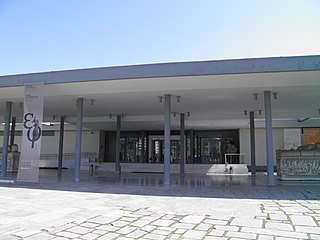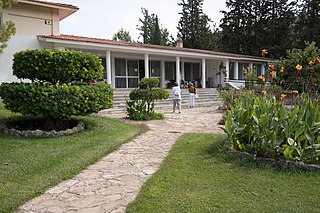The Archaeological Museum of Drama is in the city of Drama in East Macedonia and Thrace, Greece. It was built by the Municipality of Drama and inaugurated on 12 December 1999.
Its exhibits display the cultural history of Drama prefecture from the Middle Palaeolithic to 1914. The oldest finds, bones and stone tools, come from excavations in the cave at the source of the River Angitis (50,000 BC). It also displays tools, jewellery and pots from the prehistoric settlements of Sitagra and Arkadikos (6000–4000 BC) from the Early Bronze Age (many of the pots), the Late Bronze Age (finds from graves at Potami and Exohi), and from the Early Iron Age (pots, weapons, tools, and jewellery from graves in the industrial area of Drama).
The museum also has examples of Attic pottery (6th and 5th century BC); a marble bust of Dionysos, which constitutes the earliest evidence of his cult in the wider area; a hoard of coins of Philip II from an excavation at Potami; and other finds from the ancient settlement of Drama (4th century BC). Most items from the Roman period (such as the bronze statuette of Zeus) are from the city of Philippi, though some are from other areas (such as the grave stela of Tiberius Claudius Maximus, which was found at Grammeni).
The Early Christian period in the area is represented by coins and pottery from the settlements at Drama and Philippi. The most characteristic of the few monuments of the Byzantine period are a stone sundial with engraved hours (1069 AD) from the Palaiohori area; and pottery, coins, and jewellery from Drama, Adriani and Ksiropotamos.
The museum also displays a hoard of Ottoman coins, icons and architectural members from post-Byzantine churches, and a number of photographs of Drama and the surrounding area prior to liberation in 1913. Sculptures (votive monuments, architectural members, grave monuments) from the ancient period to the time of Ottoman rule are displayed in the covered atrium.

The Urnfield culture was a late Bronze Age culture of Central Europe, often divided into several local cultures within a broader Urnfield tradition. The name comes from the custom of cremating the dead and placing their ashes in urns, which were then buried in fields. Over much of Europe, the Urnfield culture followed the Tumulus culture and was succeeded by the Hallstatt culture. Some linguists and archaeologists have associated this culture with the Proto-Celtic language, or a pre-Celtic language family.

The Archaeological Museum of Thessaloniki is a museum in Thessaloniki, Central Macedonia, Greece. It holds and interprets artifacts from the Prehistoric, Archaic, Classical, Hellenistic and Roman periods, mostly from the city of Thessaloniki but also from the region of Macedonia in general.

The Hoxne Hoard is the largest hoard of late Roman silver and gold discovered in Britain, and the largest collection of gold and silver coins of the fourth and fifth centuries found anywhere within the former Roman Empire. It was found by Eric Lawes, a metal detectorist in the village of Hoxne in Suffolk, England in 1992. The hoard consists of 14,865 Roman gold, silver, and bronze coins and approximately 200 items of silver tableware and gold jewellery. The objects are now in the British Museum in London, where the most important pieces and a selection of the rest are on permanent display. In 1993, the Treasure Valuation Committee valued the hoard at £1.75 million.

The prehistory of Ireland has been pieced together from archaeological evidence, which has grown at an increasing rate over the last decades. It begins with the first evidence of permanent human residence in Ireland around 10,500 BC and finishes with the start of the historical record around 400 AD. Both the beginning and end dates of the period are later than for much of Europe and all of the Near East. The prehistoric period covers the Palaeolithic, Mesolithic, Neolithic, Bronze Age and Iron Age societies of Ireland. For much of Europe, the historical record begins when the Romans invaded; as Ireland was not invaded by the Romans its historical record starts later, with the coming of Christianity.

The Museum of Byzantine Culture is a museum in Thessaloniki, Central Macedonia, Greece, which opened in 1994.

The Archaeological Museum of Amphipolis is a museum in Amphipolis, Central Macedonia, Greece. It is located in the archaeological site of ancient Amphipolis, near River Strymon at close range of the Thessaloniki–Kavala national highway and within the walls of the ancient city itself. In the museum, finds from Amphipolis and its surroundings are exhibited. The excavations took place mainly in the period from 1956 to 1984, under the direction of the late archaeologist Dimitris Lazaridis. After his death (1985) his daughter, Calliope Lazaridis, continued the work until 1989.

The Archaeological Museum of Dion is a museum in Dion in the Pieria regional unit of Central Macedonia, Greece.

The Archaeological Museum of Nemea is a museum in Nemea, Corinthia, Greece. It was constructed by the University of California and given to the Greek State in 1984. The museum is located at the entrance to the Archaeological site of Nemea. Exhibits finds from this site and the surrounding areas, from Cooper Age (Chalcolithic) to early Byzantine era.

The Archaeological Museum of Veroia is one of the most important archaeological museums in Macedonia, Greece. The museum was established in 1965 in a building constructed especially for the purpose in Elia, one of the loveliest parts of the town. Finds from the Palaeolithic to the Ottoman period are displayed in its three halls.

The National Museum of Archaeology is a Maltese museum in Valletta, with artefacts from prehistory, Phoenician times and a notable numismatic collection. It is managed by Heritage Malta.

The Milton Keynes Hoard is a hoard of Bronze Age gold found in September 2000 in a field at Monkston Park in Milton Keynes, England. The hoard consisted of two torcs, three bracelets, and a fragment of bronze rod contained in a pottery vessel. The inclusion of pottery in the find enabled it to be dated to around 1150–800 BC.

The National Museum of the Union is a history and archaeology museum in Alba-Iulia, Romania.

Larnaca District Museum is a museum in Larnaca, Cyprus that has displays that show the "historical development of the city of Kition and the District of Larnaka in general." It was inaugurated in 1969. and was formerly named Larnaca District Archaeological Museum. It is controlled by the Department of Antiquities.

Tall Jawa is an archaeological and historical site in central Jordan.

Ancient Greek art stands out among that of other ancient cultures for its development of naturalistic but idealized depictions of the human body, in which largely nude male figures were generally the focus of innovation. The rate of stylistic development between about 750 and 300 BC was remarkable by ancient standards, and in surviving works is best seen in sculpture. There were important innovations in painting, which have to be essentially reconstructed due to the lack of original survivals of quality, other than the distinct field of painted pottery.

Archaeology is promoted in Jersey by the Société Jersiaise and by Jersey Heritage. Promotion in the Bailiwick of Guernsey being undertaken by La Société Guernesiaise, Guernsey Museums, the Alderney Society with World War II work also undertaken by Festung Guernsey.
Amasya Museum, also known as Archaeological Museum of Amasya is a national museum in Amasya, northern Turkey, exhibiting archaeological artifacts found in and around the city as well as ethnographic items related to the region's history of cultural life. Established in 1958, the museum owns nearly twenty-four thousand items for exhibition belonging to eleven historic civilizations.

This is a reflection of the main historical events in Pieria (Πιερία), Central Macedonia.
Bronze Age in Azerbaijan began in the second half of the 4th millennium BC and ended in the second half of the 2nd millennium BC, while the Iron Age commenced in approximately 7-6th centuries BC. The Bronze Age in the territory of today's Azerbaijan is divided into the early Bronze Age, the middle Bronze Age and the late Bronze Age. Bronze Age was studied in Nakhchivan, Ganja, Dashkasan, Mingachevir, Gobustan, Qazakh and Karabakh.


















